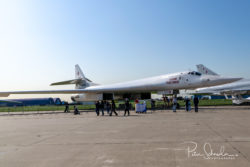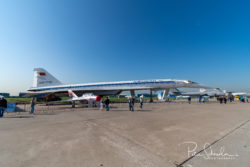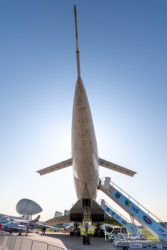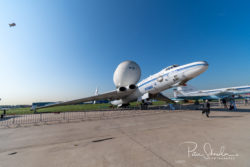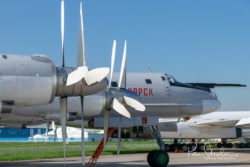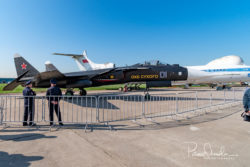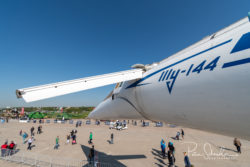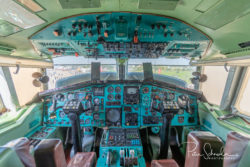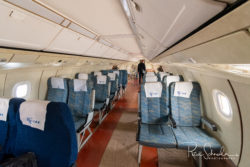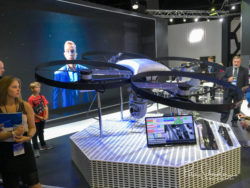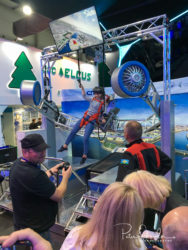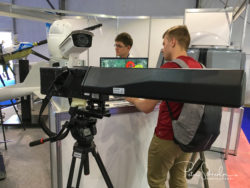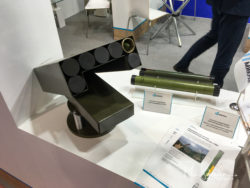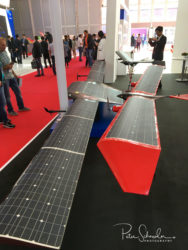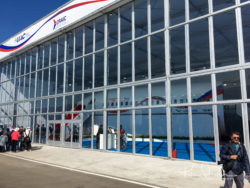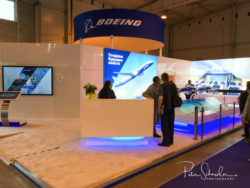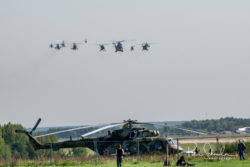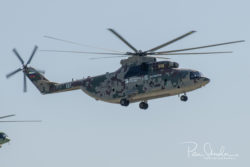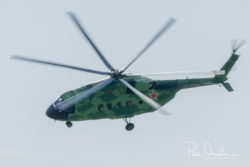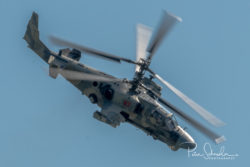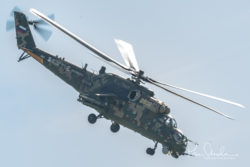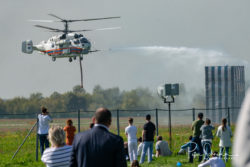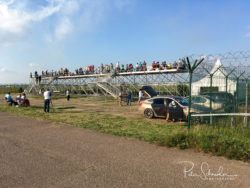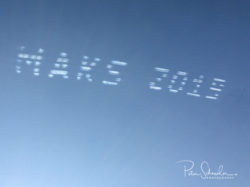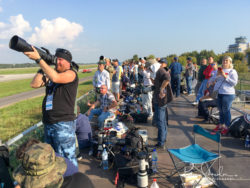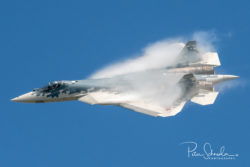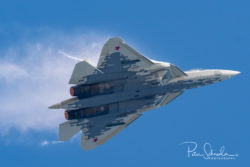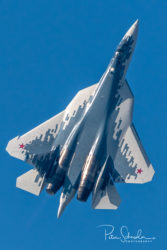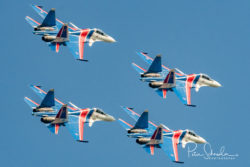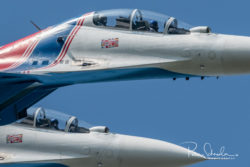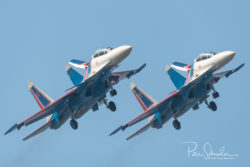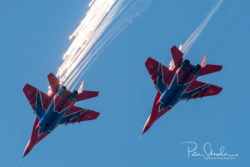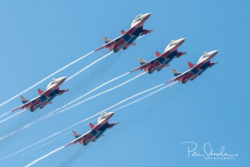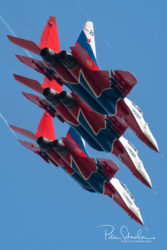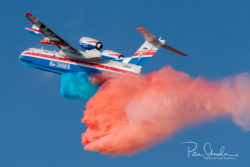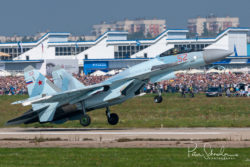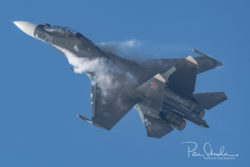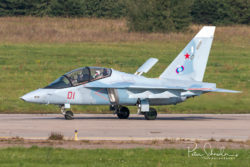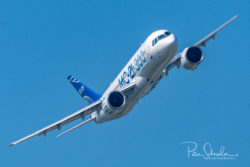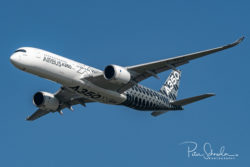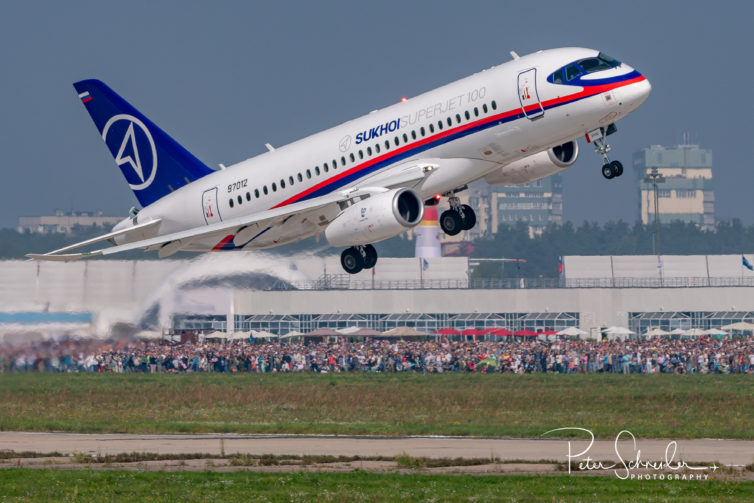
The Sukhoi SuperJet100 with Saberlet wingtips was flown by Leonid Tschikunow and he handled that SSJ like a fighter jet. Very impressive demo!
For years I have known about the MAKS aviation trade show and air show, which happens every other year in Zhukovsky, which is on the outskirts of Moscow. I had originally planned on attending this event in 2017, but the date of the show was moved up by a month so as to not conflict with another Russian military trade show, so I was not able to attend. But, fast forward to August 28, 2019: I finally embarked on my journey to Moscow.
After spending two lovely weeks of vacation in Switzerland, I flew from Zurich via Riga to Moscow’s Shermetyevo airport. After deplaning, within a matter of minutes I was through immigration, collected my bag, cleared customs and was sitting in a taxi heading for the city.
I had rented an apartment in Moscow for five nights; it was located near three train stations, which made it an ideal location for easy access by rail to Zhukovsky Airport for the MAKS airshow, and then to travel to Monino for a visit to the Central Air Force Museum.
The following morning, on Thursday, the last of the MAKS business days, I took the 7.30 a.m. express train to the Odyth station, and from there a shuttle bus to the Zhukovsky airfield. By 8:45 a.m. I was standing in awe of an Airbus A-350, which was parked right across from Irkut’s MC-21.
My main objective for the day was to check out and take pictures of the static displays and walk through the many exhibit halls, and perhaps catch some of the flight performances in the afternoon.
- TU-160
- TU-144
- TU-144 from the front
- Myasishchev VM-T Atlant
- TU-95 with its counter-rotating props
- The SU-47, in its first static display appearance at MAKS
It was nice to be on the show grounds early, as the static displays were not yet crowded and it was great to take photos of the many aircraft. I was also determined to visit the Tu-144 (aka Concordsky), and I found out that they would open up the aircraft for the public by 10 a.m.
By 9:40 a.m., I had lined up to be some of the first to get to visit the TU-144 that day. I happened to be in the second group to be able to visit the interior, which included a visit to the cockpit. And yes, I had to sit in the captain’s seat and enjoy the view for a minute. It sure was interesting to see this wide array of aircraft that we usually don’t get to see in the west, up close and personal.
- The TU-144 has retractable canards
- Cockpit of the TU-144
- Inside the Cabin of the TU-144
After a stroll through the general aviation section, I started going through the exhibit pavilions to at least walk through every exhibit hall once.
There are numerous exhibitor pavilions categorized by the various branches of the aviation industry. For example, one exhibit hall is entirely dedicated to aircraft armaments. Another exhibit hall was dedicated to Roscosmos and all about space, filled with models of rockets and rocket engines. UAVs (Unmanned Aerial Vehicles) were found at every corner at MAKS as well as within a dedicated exhibit hall, and they came from tiny to extra large for all the various applications.
Drone countermeasures was also a hot topic, with some sort of signal interference gun and even mini-rocket launchers on display.
China, as a guest nation, had its own pavilion. Other exhibit halls were dedicated to helicopters, fighter jets, and various war materials. In the commercial aviation hall I did stumble upon Boeing’s booth, which was rather small with just a few model aircraft on display and one representative sitting behind an elevated table.
Airbus was also in attendance. Their booth was bigger, though, and at they also brought the A-350-900 in the carbon livery, which they flew demos with.
- Drones came in all sorts of shapes and sizes
- A virtual-reality sky diving simulator attracted a lot of attention
- A drone-defense gun on display
- Another version of anti-drone defense
- A solar-powered UAV
- COMAC’s interior mock-up
- Boeing’s presence at MAKS was quite modest
After a ’œmystery lunch’ (didn’t know what I was ordering because the menu was in Cyrillic, but whatever it was, it was tasty) the flight activities began for the day.
As I was popping in and out of the exhibit halls I watched a few demos. Among them was the A350, the Irkut MC-21, but what was most impressive to me that day was the helicopter demos. Various types of helicopters took off together and, in one parade, departed from Zhukovsky airfield, returning about 15 minutes later in one group. After the initial group flyby, each of the helicopters put on a solo flying display.
The sheer size of the Mil-MI 26 is just so impressive, and seeing the KA-52 ’œAlligator’ doing its demo was also a treat. The helicopter demo was rounded out by the Kamov KA-32 firefighting helicopter, which put out a fire in front of the crowd.
- The helicopter parade was an impressive sight
- Mil-Mi 26
- Mil-Mi 38T
- The Kamov KA-52 during its solo display
- A Mil-Mi35
- The Kamov KA-32 doing a firefighting demo
The following morning, I boarded another commuter train out of a different train station (Yaroslavsky Station) and took the one hour ride to Monino, where I visited the Central Air Force Museum. This place is a must-visit for every AvGeek, and easy to combine while in Moscow for MAKS!
On Saturday morning I found myself once again on the train heading for Zhukovsky. Lot’s of thick fog was hanging over Moscow that morning. And as my luck would have it, that was the day that I had a ticket for the media platform. The organizers of MAKS set up a four-meter tall platform across the runway for the accredited media, along with attendees who purchased a rather expensive ticket that gains access to the media platform, which was optimally placed to allow photos of the takeoffs and landings with the sun to our back.
At 9 a.m., one hour before the flying was supposed to start, I checked in at the directorate office and then waited outside with many other photographers and media folks until we were escorted to the pickup point. We were transferred in groups of 50 across the airfield on three small shuttle buses.
At the platform, the fog was still very thick and we all knew that there will be no flying anytime soon. The time was passed with chatting with fellow photographers and periodically checking the weather, which by lunchtime slowly improved. And finally, a bit after noon, the flying demos started with the Sukhoi Superjet being the first out of the gate for that day.
With no passengers on board and only a little fuel, the pilot handled that Superjet like a fighter jet. Sadly, we missed out on the flying displays that had been scheduled for the morning, but the reward came from extra moisture in the air which made for some incredible vapor photo opportunities!
- The Media platform which is located across the runway.
- The Russian Version of the Sky Typers at work.
- Plenty of space for everyone on the media platform.
For me, the highlight of the entire show was the Sukhoi SU-57 demo, flown by chief test pilot and Hero of Russia medal recipient Sergey Bogdan. It was amazing to see what this jet can do, which seemingly defies gravity and aerodynamic laws.
The gentlemen who stood behind me during the demo posted this video of the flight on YouTube: https://youtu.be/5iVLLTlviQU
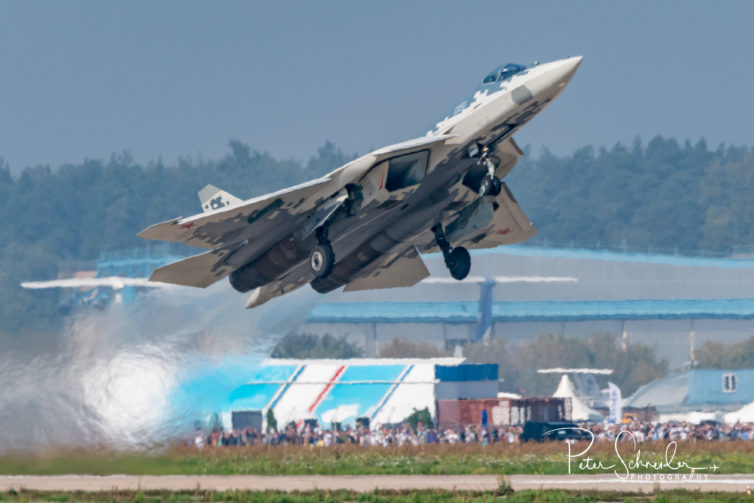
SU-57 on take-off piloted by Sergey Bogdan
- The SU-57 flown by Sergey Bogdan
- Lots of moisture in the air meant lots of vapor
- The display was fantastic as the Russian like to show off all the capabilities of this 5th-generation fighter jet
There were so many great jet demos that afternoon, I couldn’t keep track of them all. But memorable performances included the Swifts and the Russian Knights precision teams, as well as the Baltic Bees from Latvia.
- The Russian Knights Demo team using the Sukhoi SU-30SM
- A close up
- Flyby
- Mig-29 by the Swift Demo TeamFlares
- Vapor trails by the Swifts (Mig-29)
- The Swifts In formation
On Sunday, my final day in Moscow, I met up with a fellow helicopter pilot from Russia. He picked me up from my rental apartment and we drove out to the airshow. It definitely took longer to get there by car; we parked at a different airport nearby that was set up as giant parking lot. There were many people, and a very long queue to get on the bus, but the line moved quickly and we waited no more than 10 minutes to get on the bus. The weather was great, the crowds were huge but it still did not feel completely packed.
It was nice to be along with someone who is involved in aviation and able to speak Russian, as we were able to go see a couple aircraft up-close, such as a modified AN-2.
Photography of the flying demos sure was tricky from the main side of the airshow. Most all of the demos were backlit, but, fortunately, not completely impossible to work with. For takeoffs and landings, it sure would have been handy to have packed a folding step stool in order to have an unobstructed view over the two-meter high fence.
- The Berijew Be-200 doing a water drop in the colors of the Russian Flag
- SU-35
- Sukhoi SU-30
- Yakolev-YAK130
- Irkut MC-21
- Airbus A350-900
I was also delighted to see that one of the pavilions was dedicated as “Future Hub / University and Aeronautical and Technical Creation of Youth”. There were more than 40 events alone with more than 2,500 attendees.
There were roundtable discussions and conferences regarding engineering and scientific training, career events, master classes and open lectures. Besides the education pavilion there was also a huge playground set up for kids, including a tent were kids could build small plane models. There were plenty of aircraft cockpit sections for kids to sit in, along with a dedicated area for flying model aircraft and drones.
A few facts about MAKS: this year was the ninth MAKS Aviation and Space Salon. There were 578,810 attendees and exhibitors, with an estimated 200,000 attendees on Sunday alone.
On August 27th, Russian President Vladimir Putin and the President of Turkey Recep Tayyip Erdogan greeted the participants of the opening ceremony.
There were 827 exhibitors from 33 countries, along with 184 foreign companies.
The next MAKS will be mid-July 2021, and I know I will be going back again.
Learn more at aviasalon.com
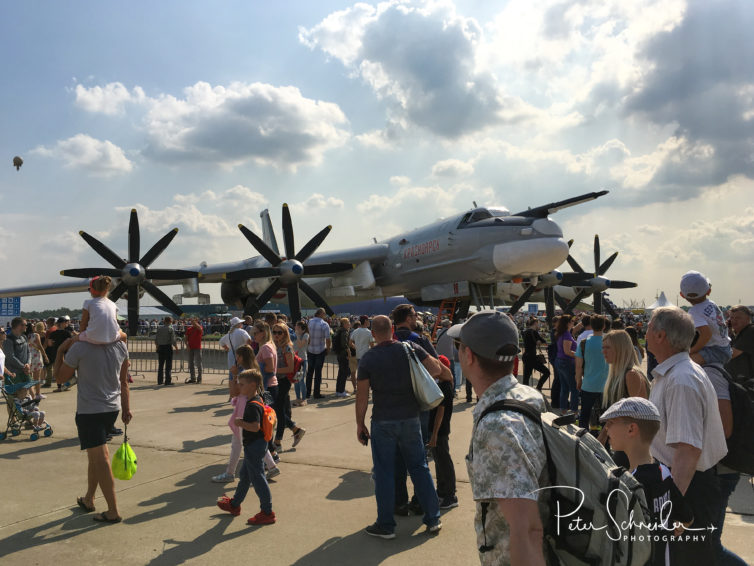
The TU-95 (Bear) is always an impressive crowd pleaser
